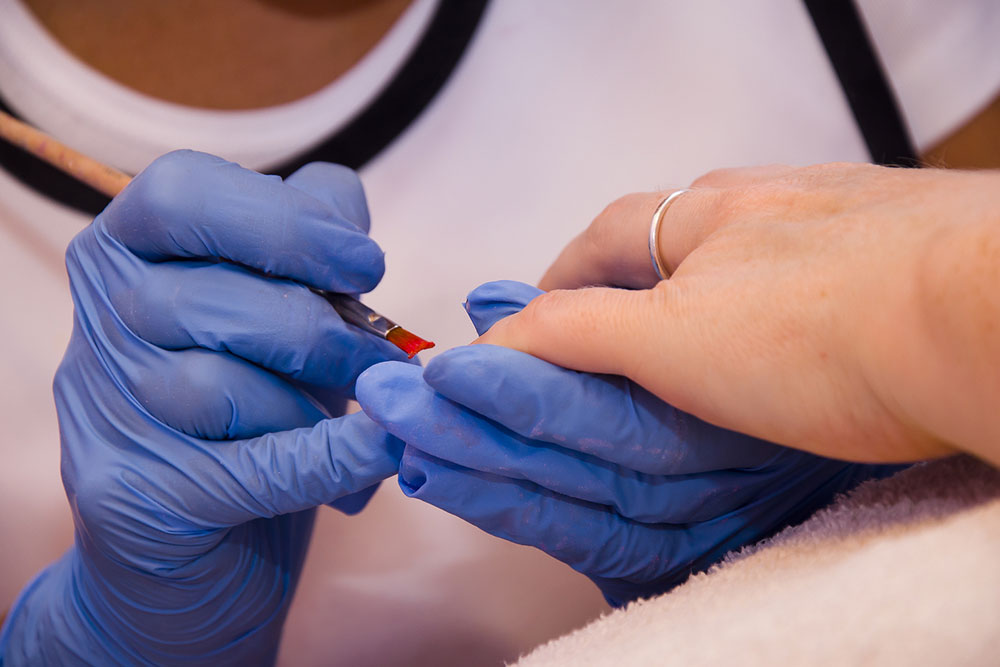Nail fungal infection – Causes, symptoms, and management

Fungus is normally present in the body, but when there is an overgrowth, it can lead to infection. One common infection is nail fungal infection, or onychomycosis or tinea unguium. It usually affects the toenails rather than the fingernails, causing them to become brittle and discolored. This infection develops over time, so any changes to the affected nails may be subtle initially. Here are some common types, causes, symptoms, and treatment measures for nail fungal infections.
Types of nail fungal infections
In general, there are four types of nail fungal infections.
Distal or lateral subungual onychomycosis
This is a common nail fungal infection caused by a type of fungus known as dermatophyte. This infection can occur in both toenails and fingernails. It usually starts as a yellowish-colored patch in the nail bed, right under the nail. Over time, this patch spreads to the center of the nail from the edges, causing the nail to separate from the nail bed.
Candidal onychomycosis
This type of infection is caused by yeast. It mostly occurs in the fingernails. The yeast causes the area around the infected nail to become inflamed and swollen. Sometimes, the nail might come off entirely from the nail bed. This usually happens when the nail has been damaged by an injury or another infection.
Proximal subungual onychomycosis
This is a rare type of nail fungal infection. It usually affects those who have autoimmune health disorders. The infection starts with the development of white spots in the center of the nail bed at the cuticle. As the nail grows, the spots start to move outwards.
White superficial onychomycosis
This is another rare nail fungal infection. It mainly occurs in the toenails. It starts as white spots on the surface of the nails. Over time, the spots become powdery, causing the nail to become brittle and crumble.
Causes
Usually, nail fungal infections occur due to fungi overgrowth in the nails. This overgrowth can happen when nails are in moist and warm environments, where the fungi thrive the most. In most cases, fungi that are already present in the body undergo overgrowth, which leads to nail infections. Also, fungal infection in the nails can occur if one comes in contact with someone who already has the infection.
In most cases, the infection occurs when there is a crack in the nail or the skin around the nail, creating an environment for fungal overgrowth. This is why toenails are more affected than fingernails since the former are generally confined to shoes, which have a warm and moist environment. Furthermore, the toes have less blood flow than the fingers, which makes it harder for the immune system to detect and prevent the infection.
Some people are more susceptible to nail fungal infections due to the presence of these risk factors:
- Older adults are more prone to nail infections due to fungus as their nails become brittle with age.
- Those with a weak immune system or a pre-existing health problem such as diabetes, blood flow issues, or psoriasis
- Those who have to wear closed shoes all day long
- Those who tend to walk barefoot through swimming pools, gym showers, locker rooms, and other warm and damp places.
- Those who live with someone who has a fungal infection
- Those who have a pre-existing athlete’s foot.
- Those who have recently injured their nail or had surgery on their foot or hands
- Those who have to wear plastic gloves or keep their hands moist for long periods.
Symptoms
The signs differ based on the type of nail fungal infection. Generally, the intensity of the symptoms starts out very mild and becomes severe over time if not treated soon. Some of the common signs of the infection include the following:
- The infection starts with the development of white or yellow spots under the affected nail. As the infection progresses, the size of the spot becomes bigger until it covers the entire nail, turning it yellow, green, white, or black over time.
- The nail becomes so thick that it becomes harder to trim it.
- The infected nail might start to curl down or up. Sometimes, it comes loose from the nail bed.
- The nail becomes brittle and crumbles on touching.
- The shape of the nail changes
- A foul smell may start to emanate from the infected nail.
If self-care measures do not help eliminate these symptoms, one must consult a healthcare practitioner. It is especially important to consult a doctor if one has preexisting diabetes or is experiencing swelling, pain, or bleeding around the infected nails.
Treatment
In many cases of mild nail fungal infection, treatment is not necessary. However, if the infection progresses to a severe stage, seeking medical intervention is recommended. A healthcare professional may suggest several treatment options based on the symptoms and the type of infection.
Antifungal prescription
This is usually the first line of treatment for nail fungal infection. The prescriptions help the new nail grow free of infection as it slowly replaces the infected part. This treatment takes about 6 to 12 weeks to get rid of the infection completely.
Antifungal nail lacquer
This involves the application of antifungal nail polish prescribed by a doctor. The polish is applied over the infected nail and the surrounding skin. It takes about a year to be effective.
Nail creams
These work similar to antifungal nail lacquer. However, these creams are not as effective in treating toenail fungal infections.
Surgery
When other treatments are ineffective, it may require surgically removing the infected nail. This allows a new nail to grow back with minimal chances of infection.
Laser or photodynamic therapy
This method uses a special light to kill off the infection in the affected nail. During the laser or photodynamic therapy, a focused beam of light is directed at the nail bed to eradicate the fungus.







